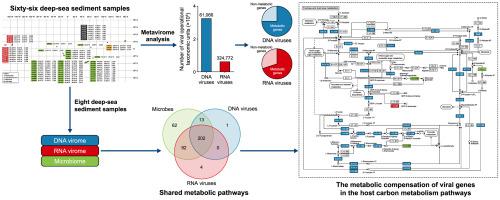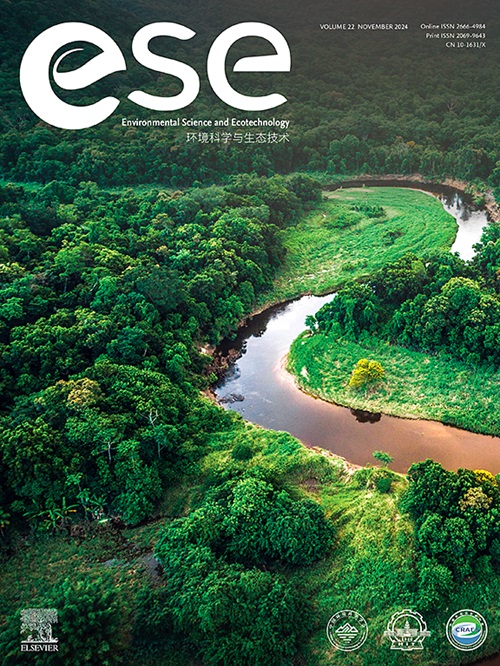Viruses are a key regulator of the microbial carbon cycle in the deep-sea biosphere
IF 14.3
1区 环境科学与生态学
Q1 ENVIRONMENTAL SCIENCES
引用次数: 0
Abstract
The marine biosphere profoundly influences atmospheric chemistry and climate through its carbon cycle. Viruses, the most abundant and diverse entities in marine ecosystems, significantly shape global carbon dynamics by infecting microbes and altering their metabolism. Both DNA and RNA viruses drive these processes in surface oceans, yet their roles in the deep sea—a sunlight-independent ecosystem that stores vast carbon reserves—remain largely unexplored. Here we show that viruses regulate the microbial carbon cycle in the deep-sea biosphere, based on viromic analysis of 66 global sediment samples spanning 1900 to 24,000 years. We identified 324,772 DNA viruses and 61,066 RNA viruses, revealing high diversity and long-term persistence. These viruses co-participate in host carbon metabolism via synergistic genes that encode carbohydrate-active enzymes, with DNA viruses primarily aiding synthesis and RNA viruses supporting decomposition. Integrated virome and microbiome data indicate that viral genes form novel metabolic branches, compensating for host deficiencies and enhancing pathway efficiency in processes like fructose-mannose and pyruvate metabolism. Our findings position deep-sea viruses as key regulators of marine microbial carbon cycling, with implications for global biogeochemical models and climate resilience. This work offers the first holistic perspective on DNA and RNA viruses in deep-sea carbon dynamics, illuminating their ecological significance across geological timescales.

病毒是深海生物圈微生物碳循环的关键调节者
海洋生物圈通过其碳循环深刻地影响着大气化学和气候。病毒是海洋生态系统中最丰富和最多样化的实体,通过感染微生物并改变其代谢,显著地影响着全球碳动态。DNA和RNA病毒都在海洋表层推动着这些过程,但它们在深海中的作用——一个不依赖阳光的生态系统,储存着大量的碳储备——很大程度上仍未被探索。本文通过对1900年至24000年的66个全球沉积物样本进行病毒组学分析,证明了病毒调节深海生物圈中的微生物碳循环。我们鉴定出324,772种DNA病毒和61,066种RNA病毒,显示出高度的多样性和长期持久性。这些病毒通过编码碳水化合物活性酶的协同基因共同参与宿主的碳代谢,DNA病毒主要帮助合成,RNA病毒支持分解。病毒组和微生物组的综合数据表明,病毒基因形成了新的代谢分支,弥补了宿主的缺陷,并提高了果糖-甘露糖和丙酮酸代谢等过程的途径效率。我们的发现将深海病毒定位为海洋微生物碳循环的关键调节器,这对全球生物地球化学模型和气候适应能力具有重要意义。这项工作提供了深海碳动力学中DNA和RNA病毒的第一个整体视角,阐明了它们在地质时间尺度上的生态意义。
本文章由计算机程序翻译,如有差异,请以英文原文为准。
求助全文
约1分钟内获得全文
求助全文
来源期刊

Environmental Science and Ecotechnology
Multiple-
CiteScore
20.40
自引率
6.30%
发文量
11
审稿时长
18 days
期刊介绍:
Environmental Science & Ecotechnology (ESE) is an international, open-access journal publishing original research in environmental science, engineering, ecotechnology, and related fields. Authors publishing in ESE can immediately, permanently, and freely share their work. They have license options and retain copyright. Published by Elsevier, ESE is co-organized by the Chinese Society for Environmental Sciences, Harbin Institute of Technology, and the Chinese Research Academy of Environmental Sciences, under the supervision of the China Association for Science and Technology.
 求助内容:
求助内容: 应助结果提醒方式:
应助结果提醒方式:


